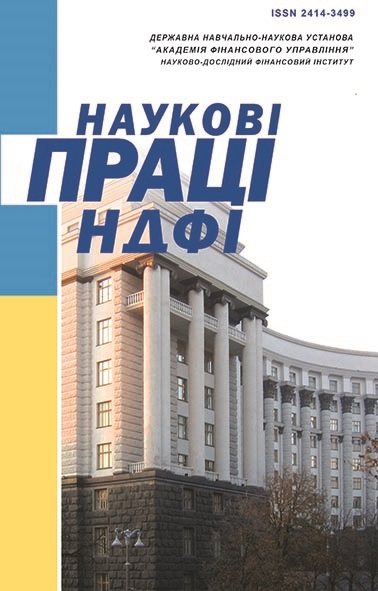
|
№ 2/2018
doi.org/10.1007/978-94-6091-555-0_1 2. Salmi, J., Hauptman, A. (2006). Innovations in tertiary education financing: a comparative evaluation of allocation mechanisms. Education Working Paper Series, 4. Retrieved from siteresources.worldbank.org/EDUCATION/Resources/278200-1099079877269/547664-1099079956815/Innovations_TertiaryEd_Financing.pdf. 3. Strehl, F., Reisinger, S. & Kalatschan, M. (2007). Funding Systems and their Effects on Higher Education Systems. OECD Education Working Papers, 6. Retrieved from www.oecd-ilibrary.org/education/funding-systems-and-their-effects-on-higher-education-systems_220244801417. 4. de Boer, H., Jongbloed, B. & Benneworth, P. (2015). Performance-based funding and performance agreements in fourteen higher education systems. Report for the Ministry of Education, Culture and Science. Center for Higher Education Policy Studies, Universiteit Twente. Retrieved from ris.utwente.nl/ws/portalfiles/portal/5139542. 5. Estermann, T., Pruvot, E. & Claeys-Kulic, A.-L. (2013). Designing Strategies for Efficient Funding of Higher Education in Europe. DEFINE Interim Report. EUA. Retrieved from www.eua.be/Libraries/publication/DEFINE_final. 6. Claeys-Kulic, A.-L., Estermann, T. (2015). Performance-based Funding of Universities in Europe. DEFINE Thematic Report. EUA. Retrieved from www.eua.be/Libraries/publications-homepage-list/define-thematic-report_-pbf_final-version. 7. Kalenyuk, I. S. (2017). Directions of transformation mechanisms funding education in the modern world. Demography and social economy, 1, 24-36 [in Ukrainian]. doi.org/10.15407/dse2017.01.024 8. Milevs'ky'j, S. V., Milevs'ka, T. S. (2015). Perspectives of higher education formula funding in Ukraine. Scientific Journal of Kherson State University, 15, 36-41 [in Ukrainian]. 9. Pidhorny'j, A. Z. (Ed.). (2017). Problems of financial management of higher educational institutions. Odesa: FOP Hulyayeva V.M. [in Ukrainian]. 10. Varnalij, Z., Krasil'ny'k, O. (2017). Optimization of financing public higher education institutions in Ukraine. Bulletin of Taras Shevchenko National University of Kyiv. Economics, 5 (194), 6-13 [in Ukrainian]. doi.org/10.17721/1728-2667.2017/194-5/1 11. Konstantyuk, N. I. (2016). In search of an effective university funding model. In O. V. Panukhny'k (Ed.). Modern socio-economic problems of the theory and practice of economic systems development (pp. 68-82). Ternopil': FOP Osadca Yu. V. Retrieved from elartu.tntu.edu.ua/bitstream/123456789/19869/1/Monograph_kaf_finans.pdf [in Ukrainian]. 12. Verby'c'ka, A. V. (2016). Funding for higher education in the European Union: strategic priorities for public policy. Series: public administration, 2, 45-50 [in Ukrainian]. 13. Tkachuk, O. V. (2017). Financial security of the higher education in Ukraine: problems and prospects. Economy and society, 12, 636-641 [in Ukrainian]. 14. Estermann, T., Pruvot, B. (2011). Financially Sustainable Universities II. European universities diversifying income streams. Brussels: EUA publications. Retrieved from www.eua.be/Libraries/publications-homepage-list/Financially_Sustainable_Universities_II_-_European_universities_diversifying_income_streams.pdf?sfvrsn=2. 15. World Bank Reimbursable Advisory Service on Higher Education Financing in Latvia. (2014, September 19). Higher Education Financing in Latvia: Final Report. Retrieved from viaa.gov.lv/files/news/24067/lv_hef_r3vsub_190922014_c_final.pdf. 16. World Bank Reimbursable Advisory Service on Higher Education Internal Funding and Governance in Latvia. (2016, December 20). International Trends and Good Practices in Higher Education Internal Funding and Governance. Retrieved from www.che.de/downloads/LV_2nd_HEd_RAS_Ph1_Trends_and_Practices_20Dec16_post_review_final_2055.pdf. 17. EACEA. (2008). Higher Education Governance in Europe. Policies, Structures, Funding and Academic Staff. Brussels: Eurydice European Unit. Retrieved from eacea.ec.europa.eu/education/eurydice/documents/thematic_reports/091EN.pdf. 18. Goksu, G., Altundemir, M. (2017). Comparison of formula financing and performance-based financing methods: the sample of higher education. The Eurasia Proceedings of Educational & Social Sciences (EPESS), Vol. 8, 52-58. Retrieved from dergipark.gov.tr/download/article-file/379783. 19. EUA. (2015). Public Funding Observatory. Report 2015. Retrieved from www.eua.be/Libraries/governance-autonomy-funding/november-2015.pdf?sfvrsn=0. 20. EUA. (2017). Public Funding Observatory. Report 2017. Retrieved from www.eua.be/Libraries/publications-homepage-list/eua-pfo-report-2017. 21. Ecker, B., Leitner, K.-H. & Steindl, C. (2012). Funding formulas for teaching in public universities: International experiences and lessons drawn from a science policy view. EUA Funding Forum. Retrieved from www.eua.be/Libraries/funding-forum/EUA_Ecker_article_web.pdf?sfvrsn=0. 22. OECD. (2010). Performance-based Funding for Public Research in Tertiary Education Institutions: Workshop Proceedings. Retrieved from read.oecd-ilibrary.org/education/performance-based-funding-for-public-research-in-tertiary-education-institutions_9789264094611-en#page4. doi.org/10.1787/9789264094611-en |
|
|
|
|
THE ACADEMY OF FINANCIAL MANAGEMENT |

|
|
|



